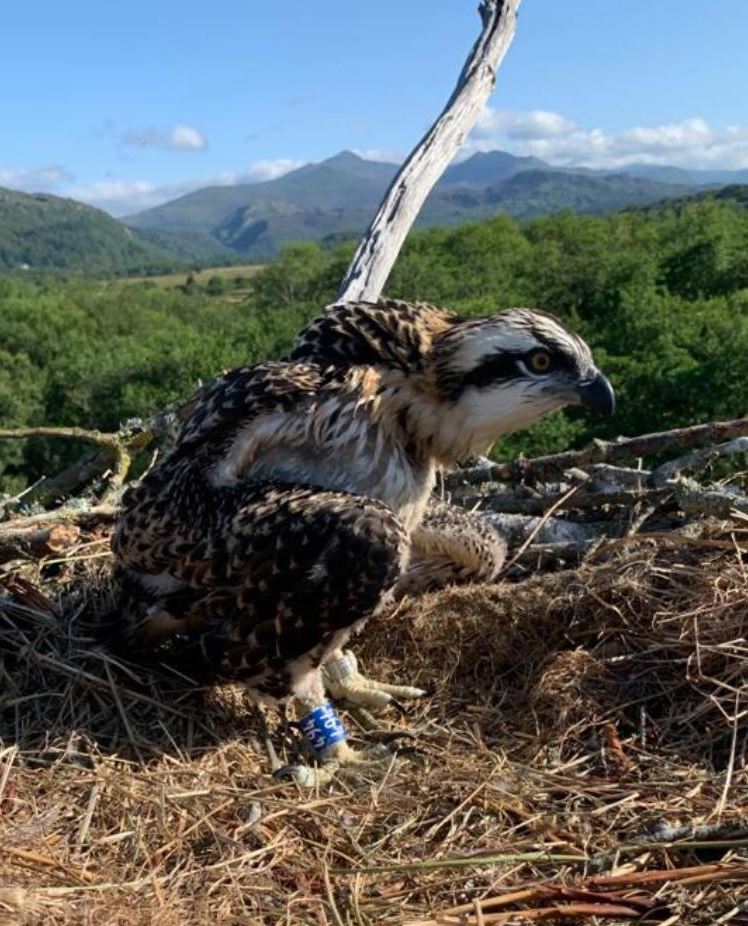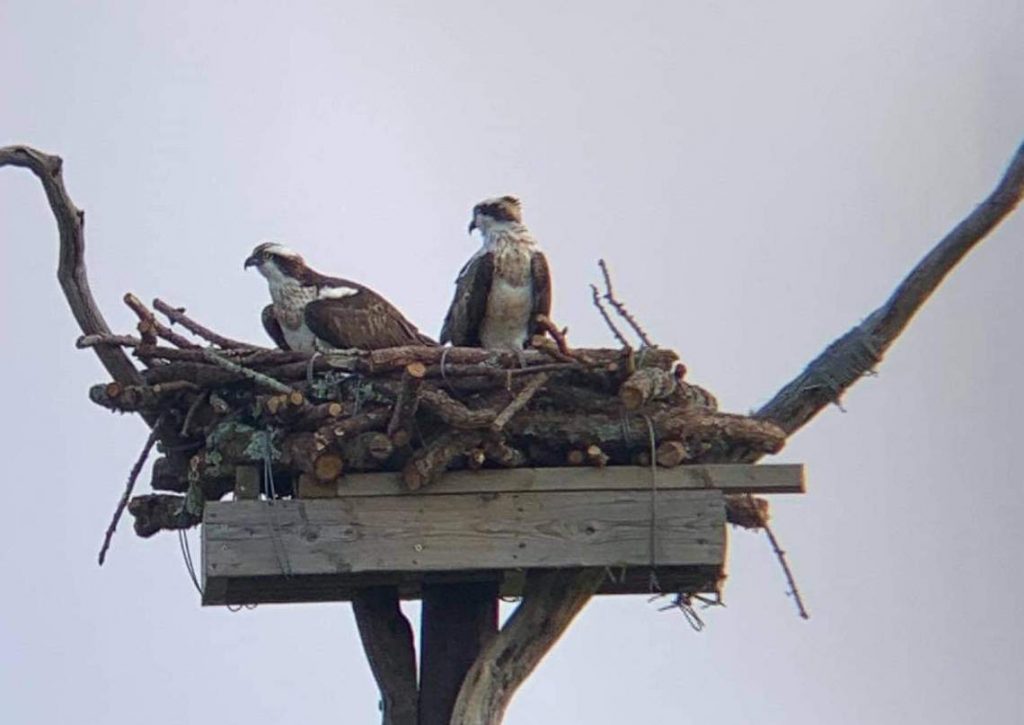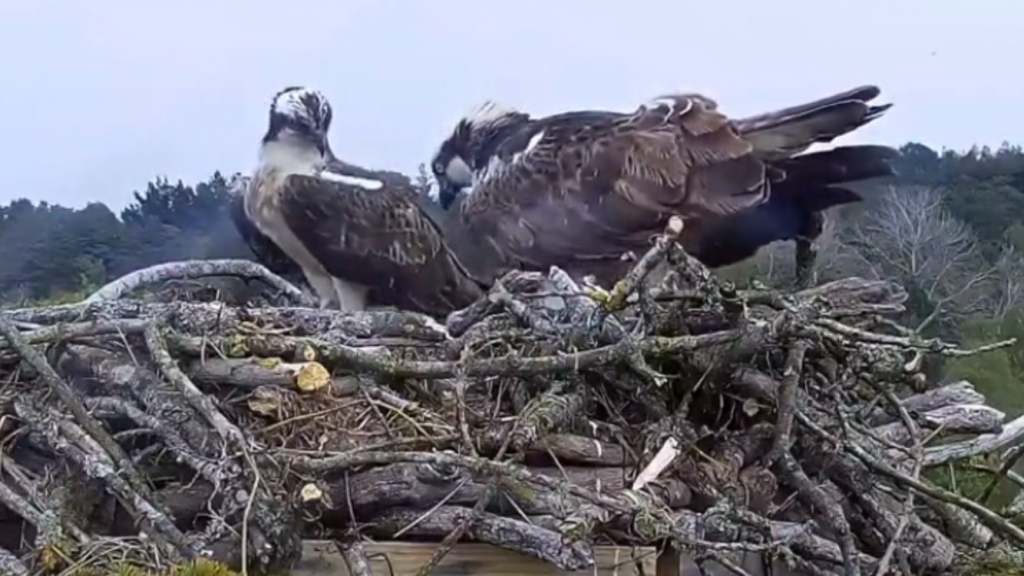Project Success: 3 Translocated Ospreys Now Breeding
We awaited the 2022 Osprey Season with a mixture of excitement and underlying trepidation as to what may unfold. With CJ7 and 022 safely back and now incubating a clutch of three eggs, the season is off to a perfect start. But, their nest is not the only achievement of the project this year...
We’re incredibly pleased and proud to report that this season there are now three of our translocated Ospreys breeding and incubating eggs! Of course, only one of these nests is in Poole Harbour (or indeed England!), despite the main aim of the translocation project being to restore a breeding population on the South Coast. So what’s going on?
The translocation project is underpinned by a key behaviour that many birds display, know as natal philopatry. Put simply, natal philopatry means that the species is generally attracted to settle and breed in their natal area, often as close as possible as to the site they themselves hatched from. In migratory species like Ospreys, this is facilitated by their ability to imprint on (i.e. memorise and form an attachment to) their local area, which appears to occur after fledging and prior to leaving on migration for the first time. Through translocation, and by moving young birds before this period, we can manipulate this behaviour so that they are inclined to return to the area of their release site, rather than the area of their natal nest. This behaviour tends to present most strongly in male Ospreys, though plenty of females also show an inclination to return to their natal site. But, at the other end of the spectrum, some females disperse enormous distances, and two Poole Harbour translocated females, 014 and 019, have done just that…
Last year, we were delighted to report that 014 was the first translocated Osprey from the project to raise young: a single male chick, which was ringed Blue 494. For those not familiar with the story, 014 was released in Poole Harbour in 2018 and was first reported back in the UK in May 2020. We were delighted to hear of her return, though slightly surprised that the report had come from our friends all the way over at the Dyfi Osprey Project in West Wales! Over the next few months, she continued to make herself known in different areas of Wales, exploring potential territories (which is very typical of young Ospreys), and even ventured down to Devon for a brief period of time. The South Coast clearly wasn’t her cup of tea however, as she was soon back in Wales, and frequently being reported with at least one young male in tow.
It came as no surprise, therefore, that when 014 returned from migration in 2021, she made a beeline straight for Wales. She set up on a nest only a stone’s throw away from the Glaslyn site at Pont Croesor, with a young male (Z2) known as Aeron, who fledged from Dyfi in 2017. The fact that the new pair raised a chick together was momentous. It meant that our project was already beginning to fulfil some of its wider, more longterm aims, in creating a link between populations in Wales, Poole Harbour and Rutland. Excitingly, 014 and Z2 are back at their nest at Pont Croesor again this year, and we are very pleased to hear that they are incubating eggs. Without a camera on the nest yet, we are unable to know how many eggs are in the clutch, but time will soon tell.
The success in Wales doesn’t stop there, however. On Monday 9th May, we were absolutely elated to hear that a second Poole Harbour translocated female, 019, has also settled on a Welsh nest with a young male, and laid her first egg! The male is KS6, another Dyfi fledged male from 2018, known locally as Dinas. This is the first breeding attempt for the pair and it comes after an interesting couple of years of sightings of 019, both in the UK and in her wintering grounds.
019 was one of the females released in the 2019 cohort of translocated juveniles (along with 022!). During that season, she was certainly a late bloomer, being the last to reach milestones throughout the project, including flight within the pens, fledging and leaving on migration. She therefore appeared to have defied the odds when she was reported in The Gambia on the 24th December 2019; an early Christmas present for the team! We were pleased to hear that she had settled in Gunjur Quarry, which is a fantastic area to choose for her wintering grounds, perfect for hunting alongside dozens of other overwintering Ospreys. Since then we’ve received regular reports of her from The Gambia, providing insight into the other side of these birds’ lives.
Hopes were therefore high for 019 to return to the UK in 2021, and she did not disappoint, arriving back in early June. But, just like 014, she was first reported in Wales, this time putting in an appearance at Glaslyn. It was great to see her back and looking in excellent condition, and bizarrely within minutes of 014 and Z2’s nest. We had a sense of déjà vu and anticipated that this would not be the last time that 019 was seen in Wales. Fast-forward to 2022, and after putting in a first brief appearance at Llyn Brenig in North Wales on May 19th, here we are, with the fantastic news that 019 is incubating on a nest with KS6, on another Friends of the Osprey nest in the exact same valley as 014 and Z2!
So, why are these females turning up in Wales? As we previously mentioned, the imprinting bond to be drawn back to their release site is weaker in females than in males (though there are exceptions there, too!). Both Dyfi and Glaslyn are on a perfect migratory flyway for birds returning to and exploring the UK for the first time. When they reach Wales, another behaviour also comes into play, referred to as conspecific attraction: Ospreys are attracted to areas where a population already exists. Happening upon the Welsh nests would have given both 014 and 019 the impression that the local area was a productive site to find a nest and a mate, and later raise young. It also doesn’t hurt that there are so many surplus bachelor males in the growing Welsh population and plenty of available nest sites thanks to conservationists putting up new artificial nests. So it didn’t take long the two females to settle in Wales, and we shouldn’t be too surprised by this movement. Indeed, it was a very similar situation that caused CJ7 to be attracted to Poole Harbour, having fledged in Rutland. With an abundance of translocated juvenile Ospreys greeting her arrival in 2017, it was easy for her to be convinced that the area would be an excellent place to raise young.
All the pieces are therefore in place for the long-term success of the project, both with the nest in Poole Harbour paving the way to establish a new population, as well as connections being formed with Wales and Rutland. We couldn’t be happier or more proud of what has been achieved so far, and we’re extremely grateful for the teams across Wales and West Africa for their work and their updates on the translocated Ospreys. We can’t wait for the rest of the season to unfold, and will be following the progress of all three of our birds with avid excitement!
You might also like...
Harbour Update – posted 22/11/24
Bitterly cold again today with more evidence of movement/arrivals with 4 Goldeneye in the harbour (2 south shore…
Find out moreHarbour Update – posted 21/11/24
With heavy rain forecast for today, it was a bit of a surprise when we ended up with…
Find out moreCall 01202 641 003
© 2024 Birds of Poole Harbour Registered Charity No. 1152615



